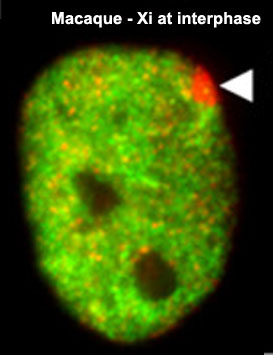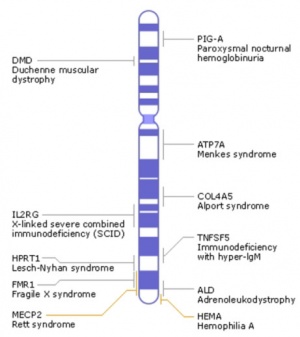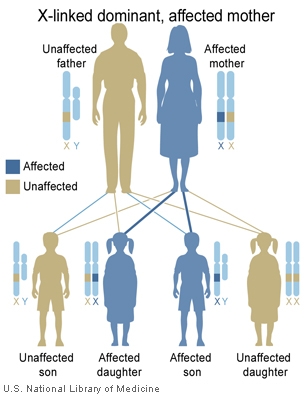X chromosome: Difference between revisions
mNo edit summary |
|||
| Line 8: | Line 8: | ||
* X inactivation occurs randomly throughout the embryo, generating a mosaic of maternal and paternally derived X chromosome activity in all tissues and organs. This can be seen in the fur colour of tortoiseshell cats. | * X inactivation occurs randomly throughout the embryo, generating a mosaic of maternal and paternally derived X chromosome activity in all tissues and organs. This can be seen in the fur colour of tortoiseshell cats. | ||
In birds, the females have a different sex chromosome, the '''W chromosome'''. Though this chromosome does not contain genes that lead to the development of a female.<ref>Evolutionary analysis of the female-specific avian W chromosome http://www.nature.com/ncomms/2015/150604/ncomms8330/full/ncomms8330.html</ref> (The male bird has a Z chromosome PMID: 9326938) (More? [[Chicken Development]]) | |||
9326938 | |||
:'''Links:''' [[Genital - Female Development]] | [[Molecular_Development_-_X_Inactivation|X Inactivation]] | [[:File:Human_genetics_chromosomes_21-XY.jpg|Genetic abnormality locations chromosomes 21-XY]] | :'''Links:''' [[Genital - Female Development]] | [[Molecular_Development_-_X_Inactivation|X Inactivation]] | [[:File:Human_genetics_chromosomes_21-XY.jpg|Genetic abnormality locations chromosomes 21-XY]] | ||
| Line 35: | Line 40: | ||
[[File:Codominant inheritance.jpg|Codominant inheritance]] | [[File:Codominant inheritance.jpg|Codominant inheritance]] | ||
===Trisomy X=== | |||
===Fragile X=== | ===Fragile X=== | ||
| Line 47: | Line 55: | ||
{{Glossary}} | {{Glossary}} | ||
{{Footer}} | {{Footer}} | ||
[[Category:Genetics]] [[Category:Chromosome]] [[Category:Molecular]] | [[Category:Genetics]] [[Category:Female]][[Category:Chromosome]] [[Category:Molecular]] | ||
Revision as of 08:54, 5 June 2015
Introduction
- 155 million base pairs
- In contrast to the Y chromosome, the X chromosome contains about 5% of the haploid genome and encodes house-keeping and specialized functions.
- Genes such as Wnt-4 and DAX-1 necessary for initiation of female pathway ovary development
- An early discovery (1961) was that in order to have correct levels of X chromosome gene/protein expression (gene dosage), females must "inactivate" a single copy of the X chromosome in each and every cell. The initiator of the X inactivation process was discovered (1991) to be regulated by a region on the inactivating X chromosome encoding an X inactive specific transcript (XIST), that acts as RNA and does not encode a protein.
- The genetic content of the X chromosome has been strongly conserved between species because these genes have become adapted to working as a single dose - Ohno's law
- X inactivation occurs randomly throughout the embryo, generating a mosaic of maternal and paternally derived X chromosome activity in all tissues and organs. This can be seen in the fur colour of tortoiseshell cats.
In birds, the females have a different sex chromosome, the W chromosome. Though this chromosome does not contain genes that lead to the development of a female.[1] (The male bird has a Z chromosome PMID: 9326938) (More? Chicken Development)
9326938
- Links: Genital - Female Development | X Inactivation | Genetic abnormality locations chromosomes 21-XY
Human Chromosomes
Human Idiogram: 1 | 2 | 3 | 4 | 5 | 6 | 7 | 8 | 9 | 10 | 11 | 12 | 13 | 14 | 15 | 16 | 17 | 18 | 19 | 20 | 21 | 22 | X | Y
X Inactivation
| The presence in females of 2 X chromosome raises the issue of gene dosage, in the case of mammals this is regulated by inactivating one of the X chromosomes.
To balance expression with the autosomal chromosomes the dosage imbalance is then adjusted by doubling expression of X-linked genes in both sexes. In some other species compensation occurs by increasing the expression of X in males.
|
 Macaque Xi at interphase[2] |
Diseases
Inheritance Pattern Images
Trisomy X
Fragile X
External Links
External Links Notice - The dynamic nature of the internet may mean that some of these listed links may no longer function. If the link no longer works search the web with the link text or name. Links to any external commercial sites are provided for information purposes only and should never be considered an endorsement. UNSW Embryology is provided as an educational resource with no clinical information or commercial affiliation.
- NCBI Genome View - X chromosome
- Ensembl Ensembl - X chromosome
- OMIM OMIM - Xist
Glossary Links
- Glossary: A | B | C | D | E | F | G | H | I | J | K | L | M | N | O | P | Q | R | S | T | U | V | W | X | Y | Z | Numbers | Symbols | Term Link
Cite this page: Hill, M.A. (2024, April 23) Embryology X chromosome. Retrieved from https://embryology.med.unsw.edu.au/embryology/index.php/X_chromosome
- © Dr Mark Hill 2024, UNSW Embryology ISBN: 978 0 7334 2609 4 - UNSW CRICOS Provider Code No. 00098G
- ↑ Evolutionary analysis of the female-specific avian W chromosome http://www.nature.com/ncomms/2015/150604/ncomms8330/full/ncomms8330.html
- ↑ McLaughlin CR, Chadwick BP. Characterization of DXZ4 conservation in primates implies important functional roles for CTCF binding, array expression and tandem repeat organization on the X chromosome. Genome Biol. 2011 Apr 13;12(4):R37. PMID: 21489251 | Genome Biol.





